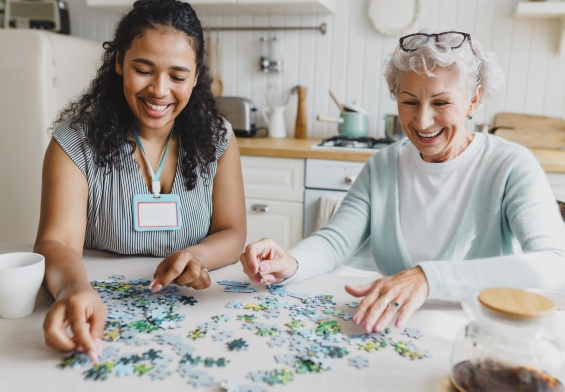Originally posted on: https://www.blogneews.com/home/tailoring-in-home-care-to-individual-needs-and-preferences/
The landscape of elder home care is undergoing a transformative shift towards a more personalized approach, recognizing the unique needs, preferences, and goals of each individual. This evolution in care philosophy underscores the importance of not just addressing the physical requirements of seniors but also nurturing their emotional, social, and cultural well-being. Tailored in-home care, with its emphasis on customizing care plans, represents a significant leap forward in how care is delivered. It acknowledges that the key to enhancing the quality of life for seniors lies in understanding and respecting their individuality, from their hobbies and interests to their cultural backgrounds and personal aspirations.
Creating individual in-home care plans is a meticulous process that begins with a comprehensive assessment of the senior’s lifestyle, needs, and preferences. This client-centered approach goes beyond traditional care models by integrating activities and preferences that resonate with the senior’s personal history and interests. Whether it’s facilitating engagement in cherished hobbies, respecting dietary and cultural practices, or working towards specific personal goals, the aim is to craft a care experience that is as unique as the individual receiving it. This level of personalization not only enriches the care recipient’s life but also fosters a deeper connection between caregivers and seniors, ultimately leading to more meaningful and effective care.
The Essence of Personalized In-Home Care
Personalized in-home care is grounded in the recognition that every individual is unique, with their own set of preferences, interests, and cultural backgrounds. This understanding has led to the development of individual in-home care plans that are as diverse as the clients themselves. By focusing on the person rather than just the care needs, providers are able to offer a more nuanced and effective service. Personalized care plans can include a wide range of services, from assistance with daily activities to more specialized medical care, all tailored to the individual’s specific requirements.
Crafting Individual In-Home Care Plans
The process of creating a custom in-home care plan begins with a comprehensive assessment of the client’s needs, preferences, and goals. This involves detailed discussions with the client and their family, as well as consultations with healthcare professionals if necessary. Providers take into account not just the physical health requirements of the client but also their emotional and social needs. This holistic approach ensures that the care plan supports all aspects of the client’s well-being.
Incorporating Hobbies and Interests
One of the key aspects of personalized in-home care is the incorporation of the client’s hobbies and interests into their daily routine. Engaging in beloved activities can significantly enhance the quality of life for seniors, providing them with joy, stimulation, and a sense of purpose. Whether it’s gardening, painting, playing a musical instrument, or any other hobby, caregivers can facilitate these activities, making them an integral part of the care plan. This not only keeps seniors active and engaged but also helps in preserving their identity and autonomy.
Addressing Cultural Preferences
Cultural sensitivity is another crucial element of tailored in-home care. Providers are increasingly aware of the need to respect and accommodate the cultural preferences of their clients. This can include considerations related to language, dietary restrictions, religious practices, and other cultural norms. By ensuring that caregivers are matched with clients based on cultural compatibility, in-home care services can offer a more comfortable and respectful environment for seniors.
Setting Personalized Care Goals
Goal setting is an important part of personalized in-home care. Providers work with clients and their families to identify specific objectives, whether they’re related to improving physical health, maintaining independence, or achieving certain personal milestones. These goals are then incorporated into the care plan, providing a clear direction for the care provided. Regular reviews and adjustments ensure that the care plan remains aligned with the client’s evolving needs and preferences.
The Benefits of Tailored In-Home Care Services
The benefits of tailored in-home care services are manifold. Firstly, personalized care plans are more effective in meeting the specific needs of seniors, leading to better health outcomes. Secondly, by incorporating the client’s hobbies and cultural preferences, in-home care can significantly enhance their quality of life. Additionally, personalized care plans can help in preventing feelings of isolation and loneliness, promoting a sense of belonging and well-being.
Examples of Customized In-Home Care Plans
Examples of customized in-home care plans abound, each reflecting the unique needs and preferences of the client. For instance, a care plan for a senior with a passion for cooking might include assistance with meal preparation, enabling them to continue enjoying this activity safely. For a client with a deep connection to their cultural heritage, the care plan might involve outings to cultural events or meals prepared according to traditional recipes. These examples illustrate the flexibility and adaptability of personalized in-home care.
Addressing Cultural Sensitivities in Elder Care
Addressing cultural sensitivities is essential in creating a welcoming and respectful environment for seniors. This involves training caregivers in cultural competence, ensuring they have the knowledge and skills to provide care that respects the client’s cultural background. By fostering an environment of understanding and respect, in-home care providers can ensure that seniors feel valued and understood.
Incorporating Hobbies into Senior Care Routines
The incorporation of hobbies into senior care routines is a testament to the innovative approaches being taken in personalized in-home care. This not only enriches the daily lives of seniors but also supports their mental and emotional health. Caregivers play a key role in facilitating these activities, providing the necessary support and encouragement for seniors to pursue their interests.
The shift towards personalized in-home care is not just a trend but a reflection of a deeper understanding of what truly matters in elder care. By focusing on the individual needs and preferences of seniors, in-home care providers are setting a new standard for quality and compassion in care. This approach has shown that when care is tailored to fit the unique personalities, cultural backgrounds, and personal goals of seniors, the benefits extend far beyond basic health and safety. It touches on the essence of what it means to live a fulfilled life, regardless of age. The integration of hobbies, cultural sensitivities, and personalized goals into care plans has proven to be a game-changer, offering a blueprint for how elder care can be more responsive, respectful, and ultimately, more human.




